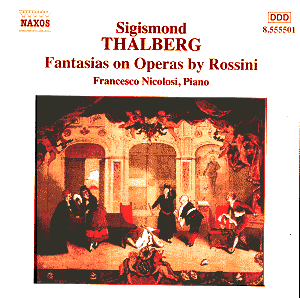 Composer: Sigismond Thalberg
Composer: Sigismond Thalberg
Works: Fantasias on Operas by Rossini: Fantasia on Semiramide, Op. 51; Fantasia on La donna del lago, Op. 40 bis; Fantasia on Il barbiere di Siviglia, Op. 63; Fantasia on Moïse, Op. 33
Performers: Francesco Nicolosi, piano
Recording: Festetitch Castle, Budapest, March 1992
Label: NAXOS
Sigismond Thalberg, a contemporary and rival of Franz Liszt, occupies a unique corner of the Romantic piano repertoire, often overshadowed by the more flamboyant virtuosity of his peers. This collection of fantasias based on operas by Gioachino Rossini presents Thalberg’s nuanced lyricism and technical prowess, showcasing his ability to transform popular operatic themes into intricate piano works. Each piece serves not only as a testament to Thalberg’s compositional skill but also reflects the operatic style of early nineteenth-century Europe, where melody and dramatic expression were paramount.
Francesco Nicolosi’s interpretation of these fantasias is marked by a keen sensitivity to the lyrical qualities inherent in Thalberg’s writing. The opening Fantasia on Semiramide unfurls with a serene introspection that contrasts with the more vigorous passages typical of the virtuoso tradition. Nicolosi’s touch is notably delicate, allowing the melodies to breathe and resonate. This interpretative choice is particularly effective in the quieter moments, where one can almost perceive a jazz-like improvisational spirit akin to Keith Jarrett’s explorations. The Fantasia on La donna del lago, while still reflective, introduces a more animated character that showcases Nicolosi’s adeptness at navigating the intricate passagework without sacrificing the lyrical flow.
The recording quality is exemplary, capturing the nuances of Nicolosi’s performance with clarity and warmth. The acoustic of Festetitch Castle provides a resonant backdrop that enhances the piano’s tonal richness. Each note is rendered with precision, and the subtle dynamics are beautifully articulated, allowing listeners to appreciate the intricate interplay between melody and accompaniment. However, the accompanying booklet notes, while informative about Thalberg’s life, fall short in providing context for the fantasias themselves, focusing instead on the operatic plots. This oversight diminishes the listener’s understanding of how Thalberg reinterprets these themes for the piano.
While the fantasias on Il barbiere di Siviglia and Moïse exhibit a more energetic and flamboyant character, they do not eclipse the emotional depth found in the earlier pieces. The brisk tempo and playful ornamentation in the former highlight Nicolosi’s technical skill but may lack the introspective nature that defines the other works. The lyrical lines in Semiramide and La donna del lago, with their subtle harmonic shifts and delicate phrasing, are where Nicolosi truly shines, drawing the listener into a reflective space.
The overall experience of this recording positions Thalberg’s work as not merely a curiosity of the nineteenth century but as a significant contribution to the piano repertoire. Nicolosi’s interpretations invite a broader audience to engage with Thalberg’s music, challenging the notion of it being exclusively for a specialized taste. For those who appreciate the romantic idiom and the piano’s expressive capabilities, this recording offers a rich and rewarding listening experience that reveals the often-overlooked depths of Thalberg’s artistry. It stands as a compelling testament to the beauty of operatic themes transposed into the intimate realm of solo piano music, worthy of both exploration and appreciation.


